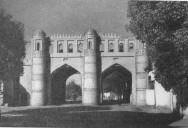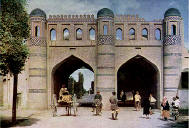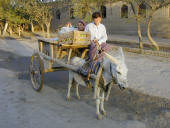




 Historical view of Kosh Darvasa
Historical view of Kosh Darvasa Gate when still in use
Gate when still in use
The Dichan Kala walls were built in 1842 by the exasperated Rakhim Kuli Khan who had suffered one Turkoman raid too many and decided to do something about it. He also wanted to be ready in case the Russian army repeated their earlier attempt to trek to Khiva when they were defeated only by the harsh winter weather. Like his impatient father, Allah Kuli Khan, Rakhim Kuli was a man in a hurry and he commanded twenty thousand Persian slaves and coerced a quarter of the population into construction work. The entire six kilometres of towering, crenellated walls and ten imposing gates are reputed to have taken a mere thirty days to complete.
The Koy Darvasa ('Sheep Gate'), also known as the Khazerasp gate, can be found half a kilometre east of the Palvan Darvasa. It was used as a customs gate and is now the bus stop for buses going from Khiva to Tashkent. The Kosh Darvasa stands north of the Bakcha Darvasa and is so-called after its two archways which allow traffic to travel in both directions. According to Soviet spin, there was a barber shop next to the Kosh Gate belonging to a revolutionary minded barber and poet named Avaz Otagi. He wrote hugely popular verses calling for an end to the despotism of Khan rule. Feruz Khan, both displeased as Khan and jealous as a rival poet, attempted to bribe his silence. When this was unsuccessful, he resorted to declaring the barber insane and having him tied to a tree in the middle of winter for a couple of days to cool his poetic passion.



